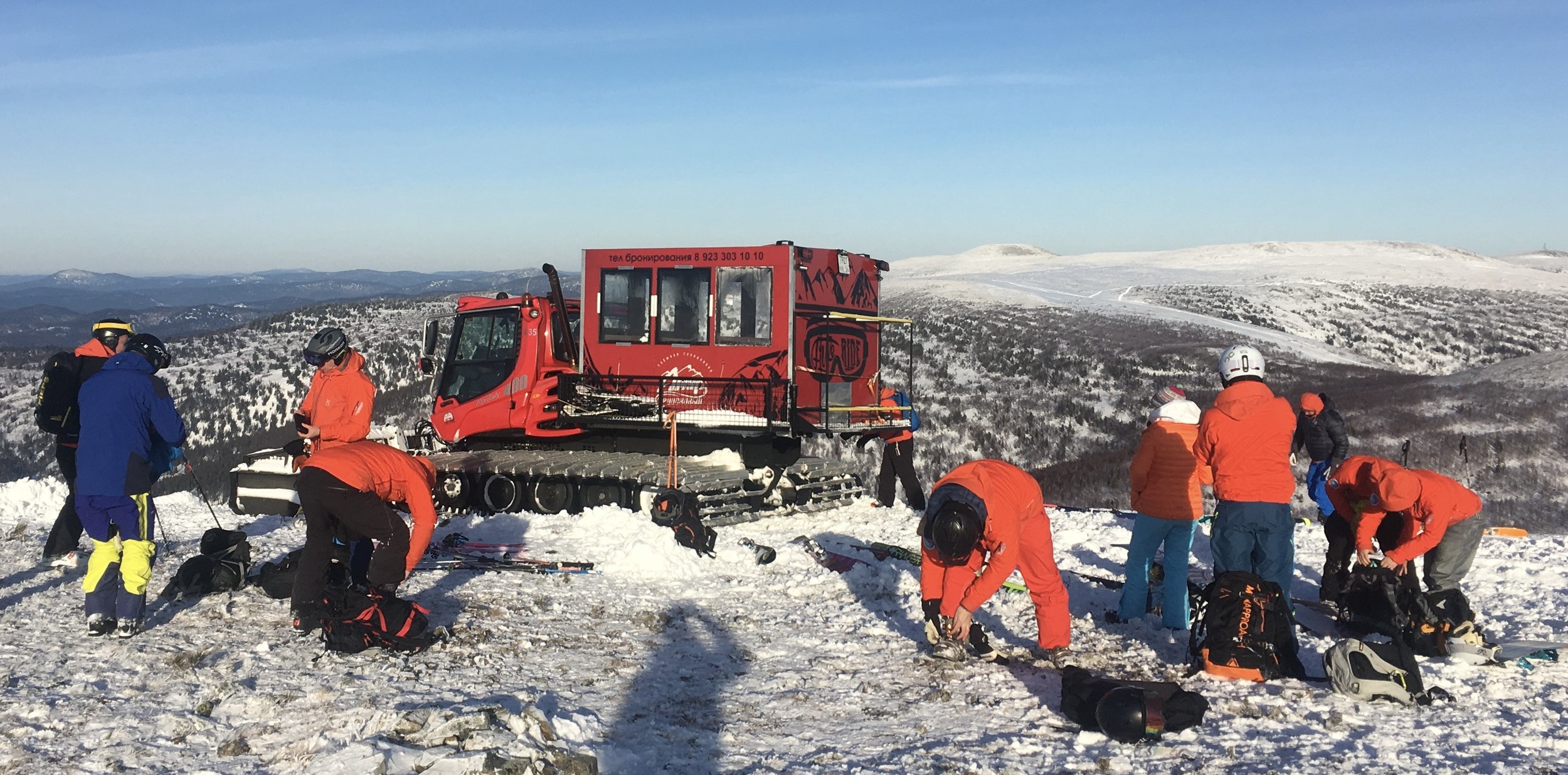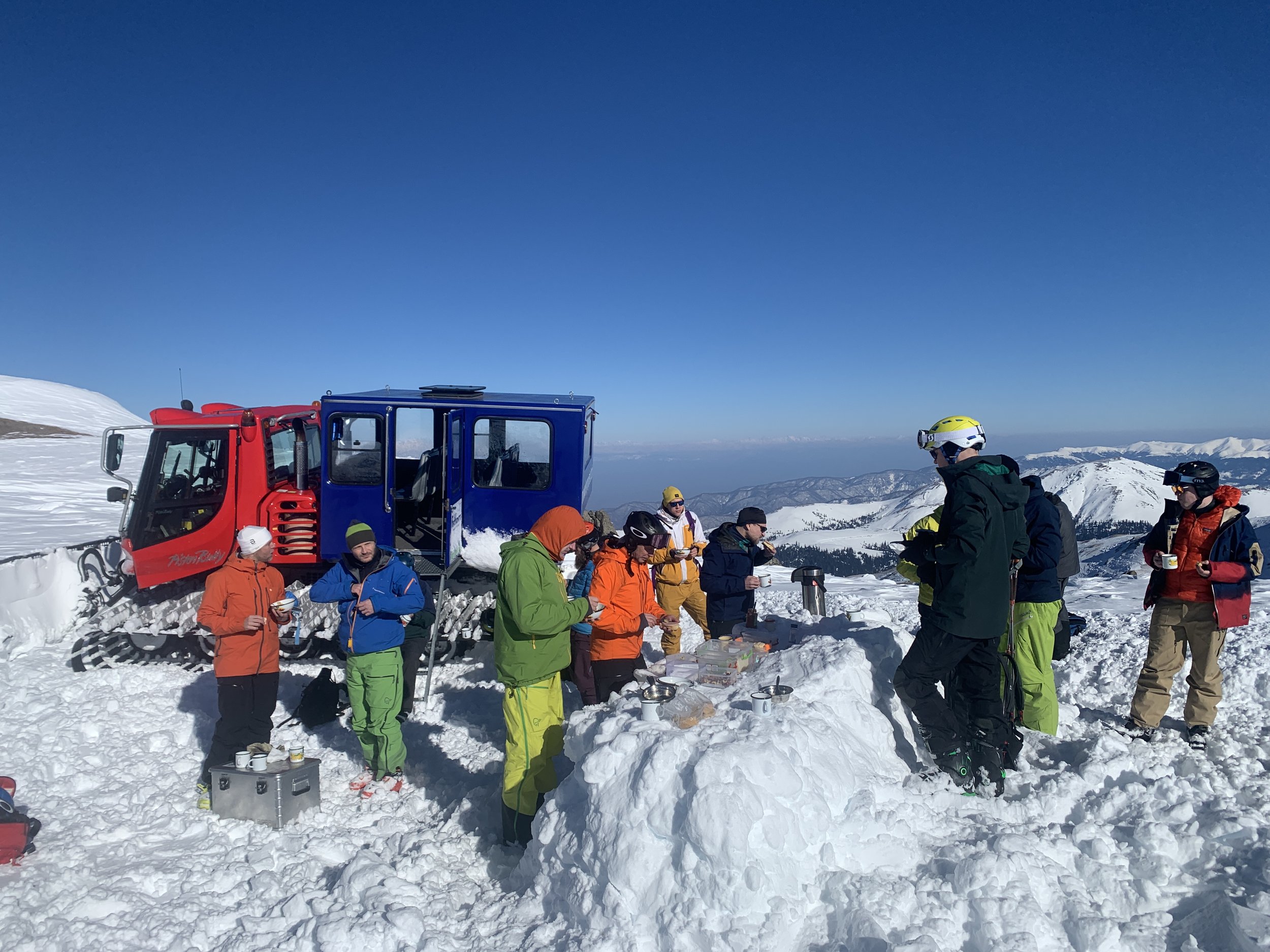What is cat skiing?
Check out Powder Universe’s winter 2024 cat skiing trips:
Ridder, Kazakhstan
Bakhmaro, Georgia
Popova, North Macedonia
General Information:
Powder Universe offers a fair number of so-called cat skiing trips. Even experienced skiers have been seen raising their eyebrows and wondering aloud about the concept of "cat skiing." Although the sport was developed over 50 years ago, many people in Europe are still unfamiliar with it.
Cat skiing involves off-piste skiing outside groomed slopes, typically in pristine natural areas. The term "cat skiing" comes from the fact that skiers are taken up the hills using a snowcat, the same vehicles used by ski resorts to maintain their slopes. These tracked vehicles, also known as snowcats, excel at moving through deep snow and can climb slopes with gradients of up to 35-40 degrees, depending on conditions.
Usually, a cabin made of aluminum or metal is mounted on the snowcat, where skiers sit. There are various types of cabins, often custom-made according to the customer's wishes, accommodating around 12 people. A typical cat skiing group consists of the snowcat driver, two guides (head guide and tail guide), and approximately 8-12 clients.
In this model, skis are placed in a box on the side.
History of Cat Skiing, a Brief Overview:
Cat skiing originated in North America, mainly in the Bugaboos mountain range in British Columbia, Canada, in the late 1950s and early 1960s. Around the same time, helicopters began ferrying skiers to mountain peaks, giving rise to heli-skiing, a much more widely recognized term. Tracked snowcat vehicles were later employed for the same purpose, offering a more cost-effective and weather-dependent alternative. Hence, the expression "poor man's heliskiing" dates back to this era.
In the 1970s and 1980s, cat skiing gradually gained popularity, especially in Canada, where vast wild mountain areas are well-suited for such activities. However, cat skiing has not achieved the same level of popularity in Europe as in North America. This is likely due to the fact that European mountain ranges offer significantly less space compared to North America. Ski resorts have already spread across these regions, leaving little room for extensive cat skiing operations.
Nevertheless, over the past two decades, cat skiing has become more common, especially in Asia and Eastern Europe.
Where Can You Try Cat Skiing?
As mentioned earlier, cat skiing originated in Canada, where it is still most widely practiced. In British Columbia, there are about twenty different companies offering cat skiing. The USA also has several cat skiing companies, although they are generally not as well-known or reputable as those in Canada.
Another region experiencing significant growth in cat skiing is Asia and Eastern Europe. Russia, Kazakhstan, Georgia, and Balkan countries such as Macedonia and Kosovo are emerging cat skiing destinations. These countries boast extensive mountainous areas with abundant snow, ideal for cat skiing.
We're here in Siberia, Russia, at the end of November or beginning of December. Unfortunately, it's unlikely we'll return there anytime soon. In this cabin model, skis were placed in the rack at the back and/or in the box on the side.
In Japan, known for its heavy snowfall and numerous mountains, there is potential for cat skiing. Japan has a unique feature not found elsewhere in the world—bankrupt ski resorts with empty slopes that could serve as excellent ascent and descent routes for cat operators. While there are already some entrepreneurs taking advantage of this, the Japanese approach to cat skiing is somewhat peculiar. In some places, skiing is only allowed on these old slopes, not beyond them. Additionally, the potential of this resource has not been fully utilized, and prices are often high compared to the experience offered. Therefore, it is advisable to carefully examine what is included in the price and the type of skiing offered before booking a cat skiing day in Japan.
Cat skiing in Western Europe and the Nordic countries remains, and probably always will be, quite limited. Availability is scarce, and legislation, as well as crowded mountains, is unlikely to allow viable cat skiing operations in these areas.
What Is a Typical Cat Skiing Day Like?
Most cat skiing vacations last 3-7 days, including accommodation, meals, and daily skiing with mountain guides. Typically, transportation from the airport is also included, using cars and sometimes a snowcat for the final leg of the journey. Often, cat skiing operators' hotels are located in places inaccessible by car, and the final stretch is covered by a snowcat.
In some places, mainly in North America and Japan, it is possible to go cat skiing for just one day. However, safety considerations and other arrangements take up enough time that the actual skiing part is often relatively short.
Lunching here in Georgia, in the Caucasus Mountains, at approximately 2800 meters altitude.
Typically, in multi-day cat skiing packages, the day starts with breakfast around 7-8 am, and around 9 am, skiers transition to the snowcat, parked directly in front of the hotel. In the morning, you usually ski about 4-6 descents, followed by lunch. Lunch is often enjoyed in the field, but if the weather is extremely cold and poor and the day's skiing area is near the hotel, you might return to the hotel for lunch.
Delicious Georgian lunch in the sunshine amidst untouched powder fields, not bad at all!
After lunch, you typically ski another 4-6 descents, and then the day is usually wrapped up. The return to the hotel is most often by cat, but sometimes it's possible to ski back to the hotel. Sauna, hot tub, and après-ski drinks by the fireplace (and social media updates!) are waiting.
In cat skiing, the vertical drops usually range between 300 and 500 meters, and the typical daily skiable vertical drop varies between 3 and 4 kilometers. Climbs back to the top for the next descent usually take around 20-30 minutes. Occasionally, if you go far from the hotel, the first ascent in the morning might take longer, even 45-60 minutes, but this is quite rare. In other words, heli-skiing covers more vertical meters per day, but it's also much more expensive and produces significantly more harmful emissions than cat skiing.
Cat skiing also has some notable advantages over heli-skiing. Firstly, because the cat skiing group (8-12 skiers) has the same snowcat at their disposal all day, it's possible to stay in the cat to rest/warm up/adjust equipment while the cat drives down to pick up skiers again. This is rarely possible in heli-skiing because one helicopter transports two or three groups throughout the day. Another significant advantage is that when it's snowing heavily (and snow is at its best and lightest), the helicopter stays on the ground behind the hotel, and people play cards inside. Meanwhile, the snowcat enjoys the snow and happily plows through forest trails while the happy skiers are blasting thru the powder!
Inside the snowcat, there are almost always heating devices, so it's rarely too cold during cat skiing, although the weather can sometimes be quite chilly, especially in Siberia.





